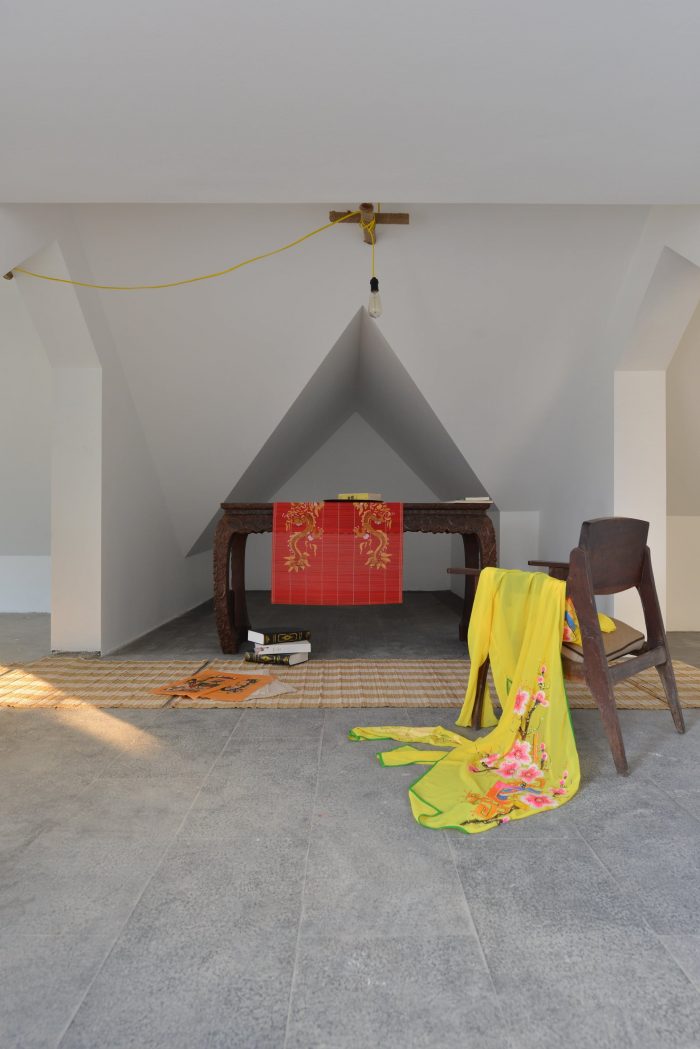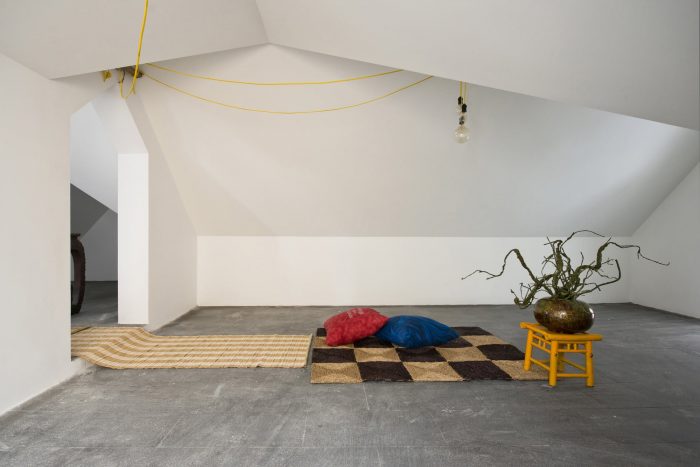这个空间原来是老宅的卧室(三楼)的上面部分,里面设置了许多技术系统(电力系统、水系统和空调),这部分相当高。我们增加了一个楼层,以便将其高度分为两部分,目的是为了创造一个额外的楼层(同时,下面的卧室仍然保证其高度),以达到仓库的目的。
This space was originally an above part of the bedroom (at the 3rd floor) of the old mansion which is set up many technical systems (electric system, water system, and air-conditioner), and this part is quite high. We have added one more floor in order to divide its height into two parts with the aim of creating to an additional floor (meanwhile, the underneath bedroom is still assured its height) for the purpose of the warehouse.
当为技术系统和仓库创造一个独立的楼层时,建筑师和房主都发现这个新的空间非常有趣,当然,他们决定它应该是一个多功能的空间,为公寓服务。它也可以用来看书,挂吊床,做瑜伽,冥想,或者简单地存放房主在各地参观时收集的一些纪念品。
When creating an independent floor for technical system and warehouse, both the architects and the householder find that this new space is very interesting and of course, they decide that it should be a multifunctional space to serve for the apartment. It is also used to read book, hang the hammock, do yoga, and meditate or simply to store some souvenirs that the house owner collected when visiting everywhere.
楼梯被移到另一个地方(根据所有下面楼层的功能),以便在上屋顶时感觉它更高,但屋顶是不变的。此外,利用横梁式屋顶也有助于我们创造层次,以创造各种不同的空间。此外,我们还利用了古老的对角线,并与十字拱门相结合,形成一个统一的整体–折纸。
The staircase is moved to another place (in accordance with the function of all underneath floors) so as to make feel it higher when going up the roof, but the roof is unchanged. Moreover, taking advantage of the cross-beam roofs also helps us to create layers in order to make a variety of different space. Additionally, we have also made use of the old diagonal, and combined with cross arches to create an unified whole – origami.
挂吊床的空间比较高,因为下面的地板上有一个厕所。在这个空间旁边,我们设置了一个空隙,以获得所有底层的光线,也使其成为这个概念的亮点。
在空隙的玻璃屋顶下有一面挂着Dong Ho画(一种越南民俗画)的墙。
The space for hanging the hammock is higher because there is a WC in the underneath floor. Beside this space, we set a void to get the light for all underneath floors and also make it as the highlight for this concept.
There is a wall that is hanged on Dong Ho picture (a kind of Vietnamese folk painting) under the glass roof of the void.
这些自然的颜色、红石、蓝叶、扇贝、花朵、木头和竹叶的煤炭……都集中在东河的画纸上。事实上,这些颜色和纸张在全国各地都存在,但只有东河人知道如何使用它们作为艺术材料。自然界色彩中的可用性成为宝贵的艺术材料。光滑而有光泽的 “Dzo “纸只能用来写诗。但在涂上牡蛎壳或红石的颜色后,纸就可以转变成闪闪发光的星空。这些线条非常灵活和连贯。由于东河人的创造力和天赋,非常简单的东西已经成为国家的艺术财产。东胡人为人类贡献了这样一种宝贵的美。
These colors of natural, red stone, indigo leaves, scallops, flowers, wood and coal of bamboo leaves… have been concentrated on the Dong Ho’s painting paper. In fact, those colors and papers exist everywhere in the country, but only Dong Ho people know how to use them as art materials. The availability in nature colors becomes valuable art materials. The smooth, shiny “Dzo” paper is for writing poem only. But after coated colors from oyster shell or red stones, the paper can be transferred into glittering stars sky. The lines are very flexible and coherent. Due to creative, talent mind of Dong Ho people, the very simple things has become nation’s art property. Dong Ho people have contributed to human-kinds such a valuable beauty.
Architects: Landmak Architecture
Area : 110 m²
Year : 2015
Photographs :Le Anh Duc
Country:Vietnam

















